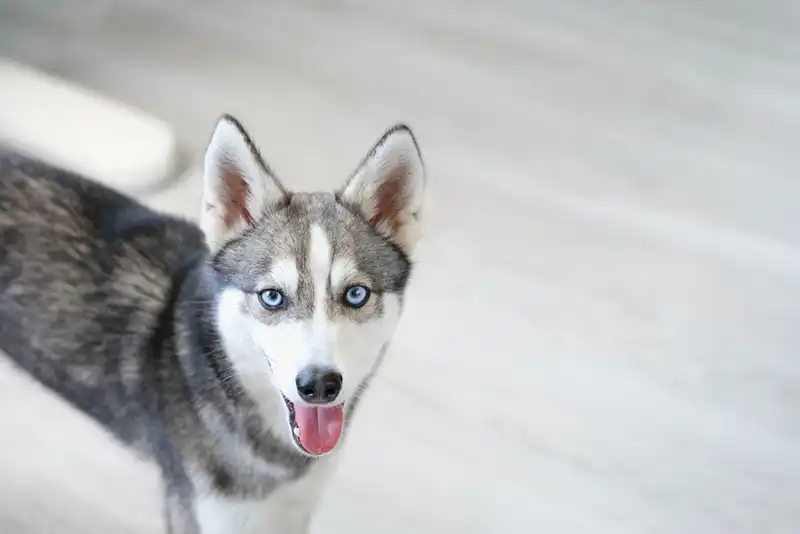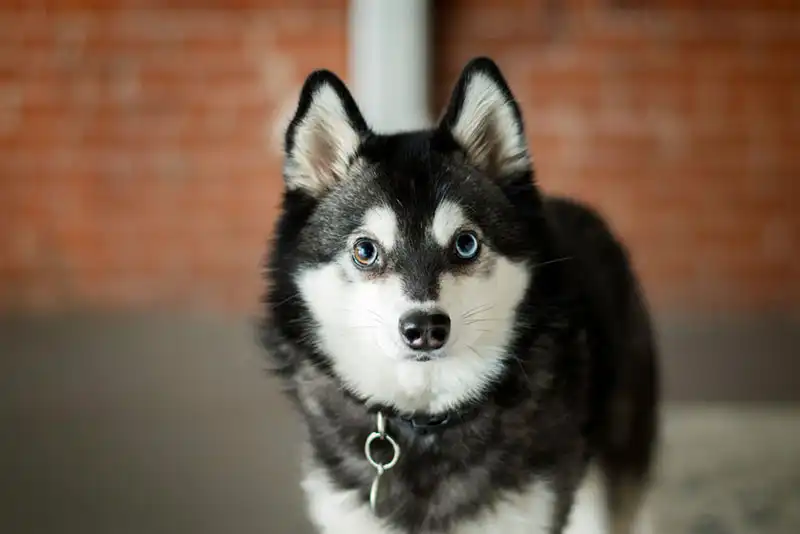Description of the Alaskan Klee Kai’s appearance
Country of origin: USA
Size: medium
Height: 33-43 cm
Weight: 4-10 kg
Age: 12-16 years
FCI breed group: not recognized

Key facts
A very young breed , its history spans only about fifty years.
Officially it has 3 names: Alaskan Klee Kai, Mini Husky, Miniature Alaskan Husky.
The breed was originally called the Klee Kai, which means “little dog” in the Athabascan language, and became the Alaskan Klee Kai in 1995.
In the very short period of their existence, the dogs have managed to establish themselves as excellent family pets and, in addition, good guards. These dogs are endowed with high intelligence, due to which they can demonstrate considerable stubbornness. They are very attached to their owners, get along well with children and willingly play with them, but they can show alienation and distrust towards strangers.
The most noticeable distinguishing feature of the breed is the “mask” on the muzzle – dark glasses with white eyebrows turning into a clear dark stripe in the middle of the muzzle.
There are three varieties of dogs, they differ in height at the withers. Toy – the smallest, “toy”, do not grow more than 33 cm. Miniature dogs are slightly taller – from 33 to 38 cm, and, finally, standard individuals can reach a height of 43 cm. All three types of Klee Kai are recognized by the UKC (United Kennel Club), and can take part in the events of this organization.
Historical background of the breed
The breed was developed not so long ago, in the 70s of the last century. As you can easily guess from the name, their homeland is Alaska, the city of Wasilla. Linda S. Spulin, who was engaged in breeding, wanted to get a smaller version of the Alaskan Husky . That is, a companion that could be kept in urban conditions, but at the same time avoid the features of dwarfism and the problems associated with this feature.
The ancestor of the dogs was a husky named Curious, distinguished by her unusually small size, which Mrs. Spelen once saw at her friends’. Linda and her family liked the little one so much that they persuaded their friends to give them the charming doggie.
Since the early 1970s, the Spelin family has carefully selected the animals that became the ancestors of the Alaskan Klee Kai. Among them are an Alaskan Husky, a couple of Siberian Huskies , an Eskimo Dog , and a Schipperke .
At first, Linda Spelen bred the new breed solely for her own pleasure, but in 1988, the pets were presented to the general public, and puppies became available for purchase. From the moment of their appearance, mini-huskies caused an unusual stir, people came from other states and lined up for the dogs, which prompted Mrs. Spelen and her family to write a standard and engage in development.
In 1990, Linda founded the Klee Kai Association, and in 1995, the prefix “Alaskan” was officially added to the name, and at that time, the mini-husky was registered with the American Rare Breed Association (ARBA). And two years later, it received recognition from the UKC, and later a number of other cynological associations joined them.
Alaskan Klee Kai were brought to Russia only in 2013, and are registered here by the Union of Cynological Organizations of Russia (SKOR) and the World Cynological Alliance (Alianz Canine Worldwide).
Since its appearance, the breed continues to gain popularity, but remains rare, although there are already several nurseries in Russia that breed it.

Description of the Alaskan Klee Kai’s appearance
This is a small, graceful dog with thick fur, very energetic, strong and proportionately built, with almond-shaped or oval eyes, which, like one of its ancestors – the husky – can be of different colors.
By the way, their descendants are most similar to the Alaskan Husky, although there are differences – for example, the ears of the Klee Kai are quite large in relation to the head. The funny “mask” on the muzzle gives them a resemblance to a cartoon character, and their small stature and energy enhance this.
The fluffy tail falls in a ring on the back or to the side. The dogs have a friendly nature, aggression or cowardice are unacceptable for them.
Below is the official standard of the UKC, the organization that accepted this breed.
Head
It is small, proportional to the body, slightly rounded, without wrinkles and folds on the skin.
The muzzle is approximately equal in length to the head, narrower towards the nose when viewed from the side or from above. The lips should not be pendulous. The transition from the head to the muzzle is moderate and distinct.
Eyes
They can be any color or multi-colored (heterochromia does not affect the health of the eyes, it is one of the characteristics of the breed), as is often the case with huskies. The most desirable shape is almond-shaped. But there are also oval and round ones.
Ears
The triangular ears stand on cartilage, are directed upwards, fluffy, unusually sensitive and mobile. Their skin is thick. They seem large in comparison with the head, the tips are slightly rounded.
Neck
It is of medium length, arched, not arched. Proportional to the body, should not be too thick or long. When the dog is standing, the neck is raised, when running – slightly extended forward.
Frame
The length of the body should be slightly greater than its height. The withers are slightly higher than the croup, the back is straight and strong, the sides are rounded, but not barrel-shaped. The chest is of medium width, slightly protruding forward. The croup is wide and slightly sloping, the loin is strong and short.
Tail
The fluffy tail is set slightly above the line of the back. If the dog is calm, it can hang down, if the dog is moving, interested in something, then the tail falls in a loose ring on the back or on the side. It is better that it is not curled too tightly, the tip of the tail in a curled state must necessarily lie on the back or to the side.
Limbs
The legs are straight, strong, proportionate to the body, the shoulders are slightly set back, the elbows are close to the body. The shoulders and hocks have a moderate angle of inclination. The legs are parallel to each other, their placement is of medium width. The pads are oval in shape, elastic and thick, small. There is quite a lot of hair between the toes.
Gait and movements
The dog’s movements are smooth, effortless, dexterous and light. From its northern ancestors, the Alaskan Klee Kai inherited a special manner of moving: when the mini-husky runs, its paws gradually come closer together, and the tracks form an even chain.
Klee Kai wool
The coat is of medium length, with a soft, thick undercoat. The coat is fluffy and should not hide the animal’s silhouette. The dog has a beautiful “collar” on its neck, and some may have longer hair on the back of its paws.
The shedding is profuse, the undercoat usually falls out completely. It is important to add that the Alaskan Klee Kai’s coat does not have a strong doggy smell even after washing. It is considered to be hypoallergenic.
Color
Different color variations are allowed: black and white, gray and white, red with white. But the mask on the muzzle must be clearly and distinctly drawn, and on the chest, inner part of the paws, belly and “pants” there is white contrasting fur.
Within each color group there are variations, such as wolf gray and light gray, dark, brick red and light red. Pure white dogs are not allowed to be shown or bred, as this color is not included in the breed standard.
Particular attention is paid to the “mask”. The best option is when the dark contrasting color passes from the head into the “mask”, going down under the eyes and on the bridge of the nose, but not lower than the middle line of the muzzle. Light markings above the eyes – “eyebrows” – are mandatory.
Another desirable mark is a white arrow down the center of the head, it can reach the forehead, but not lower, and go down to the muzzle.
The color should be even, symmetrical, contrasting, without spots, except for light markings above the eyes. The nose and lips are black, but in red dogs they can be liver.
Let’s say a “snow” nose – with a uniform black nose lobe there are pink spots, but a single-color nose is preferable.
Size
The Alaskan Klee Kai breed is available in three sizes:
Toy dogs are the smallest, growing up to 33 cm (13 inches) at the withers and weighing 4.5.
The miniature version is slightly larger, from 33 to 38 cm (13-15 inches), weight – up to 6.8 kg.
The largest dogs are presented in standard size – their height can reach 38-43 cm at the withers (17-17.5 inches), and their weight – up to 10 kg.
All three types are officially registered in the breed standard and can participate in exhibitions.
Alaskan Klee Kai Personality
This dog was bred to be a companion with high energy and intelligence.
Of course, temperament varies from animal to animal, but don’t expect a Klee Kai to sleep peacefully for most of the day. This breed needs exercise and constant interaction with people. If your dog gets bored, it will act up and look for entertainment on its own.
Boys are more often friendly and docile than girls, who are more emotional, persistent and even cunning. But, ultimately, you will not find much difference in the character of both.
The Alaskan Klee Kai is curious, active, playful, intelligent and loyal.
Most dogs of this breed like to “talk”, they can use different sounds to beg for affection and communication, complain about something, howl and object when they are unhappy. Many owners over time begin to distinguish intonations and understand what their pet is “saying”. The breed is considered quite noisy. You need to wean the dog from this habit from an early age. This is especially important for owners living in an apartment building with neighbors.
Dogs get along well with children and are happy to play with them, but (and this rule applies to any breed) it is imperative to teach the child how to handle the animal.
Klee Kai are much more cautious and distrustful of strangers than their husky ancestors. Their protective instinct is well developed. Their intelligence and ability to be alert indicate that they can become excellent protectors. Being observant and cautious, the dogs can warn their owner about strangers, but at the same time remain calm.
The character of dogs is usually described as balanced, friendly and loyal. Dogs love to spend time with family. They will be happy to spend time together in nature. They have a high energy level, are smart and friendly towards people they know well. These dogs are ideal partners for active and athletic people. To make them sociable, early socialization and proper upbringing are essential.
